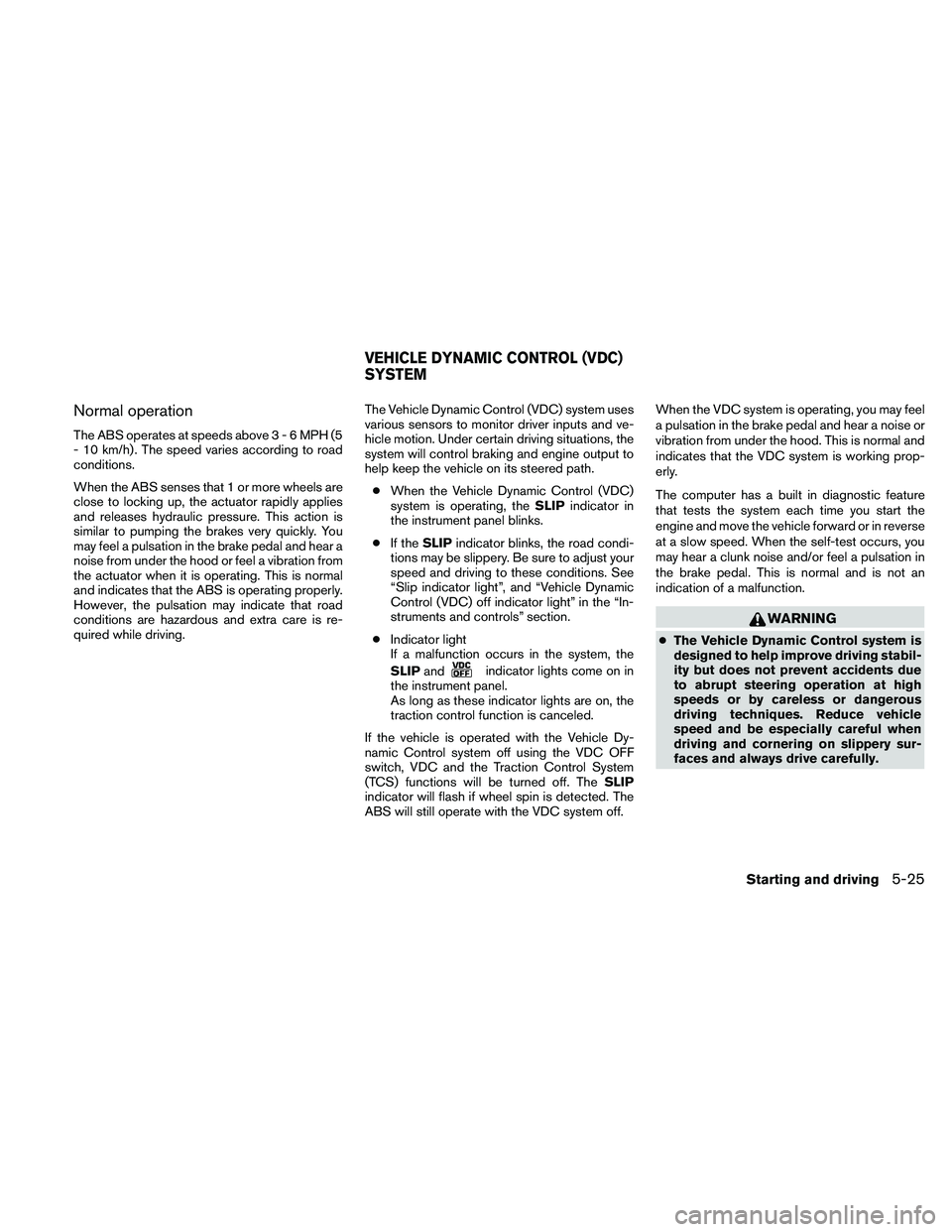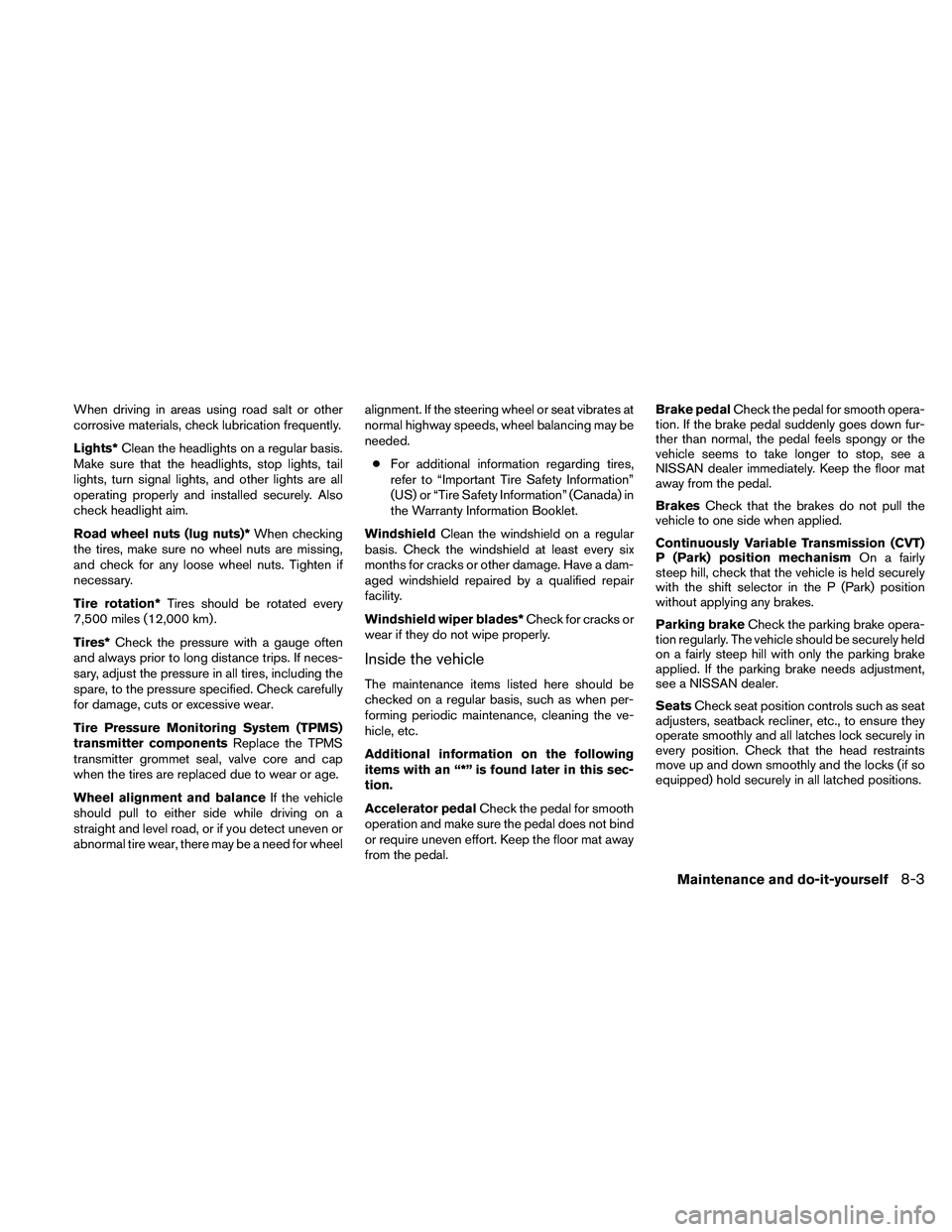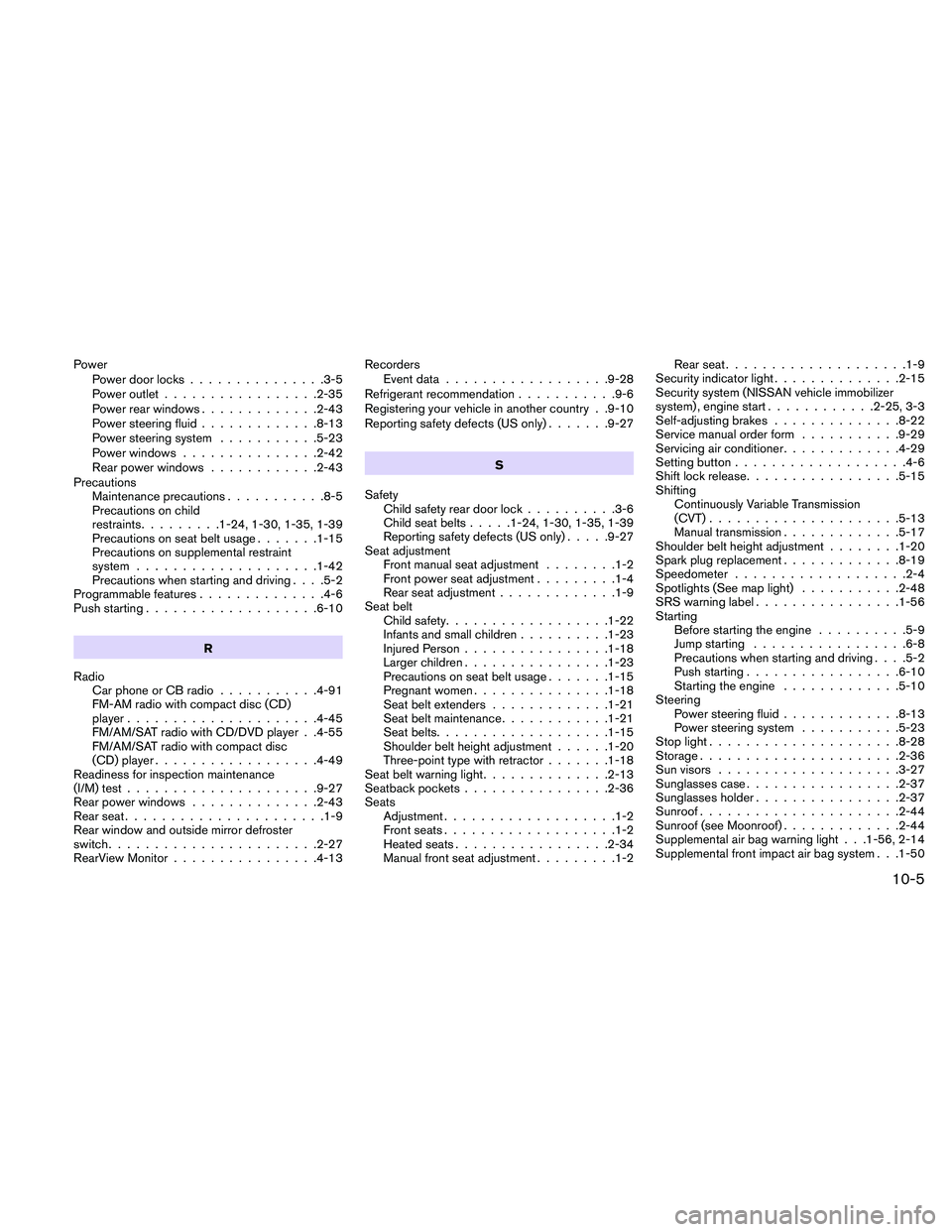2010 NISSAN ALTIMA brakes
[x] Cancel search: brakesPage 327 of 438

To dry the brakes, drive the vehicle at a safe
speed while lightly pressing the brake pedal to
heat up the brakes. Do this until the brakes return
to normal. Avoid driving the vehicle at high
speeds until the brakes function correctly.
ANTI-LOCK BRAKING SYSTEM
(ABS)
Page 328 of 438

Normal operation
The ABS operates at speeds above3-6MPH(5
- 10 km/h) . The speed varies according to road
conditions.
When the ABS senses that 1 or more wheels are
close to locking up, the actuator rapidly applies
and releases hydraulic pressure. This action is
similar to pumping the brakes very quickly. You
may feel a pulsation in the brake pedal and hear a
noise from under the hood or feel a vibration from
the actuator when it is operating. This is normal
and indicates that the ABS is operating properly.
However, the pulsation may indicate that road
conditions are hazardous and extra care is re-
quired while driving.The Vehicle Dynamic Control (VDC) system uses
various sensors to monitor driver inputs and ve-
hicle motion. Under certain driving situations, the
system will control braking and engine output to
help keep the vehicle on its steered path.
● When the Vehicle Dynamic Control (VDC)
system is operating, the SLIPindicator in
the instrument panel blinks.
● If the SLIP indicator blinks, the road condi-
tions may be slippery. Be sure to adjust your
speed and driving to these conditions. See
“Slip indicator light”, and “Vehicle Dynamic
Control (VDC) off indicator light” in the “In-
struments and controls” section.
● Indicator light
If a malfunction occurs in the system, the
SLIP and
Page 356 of 438

When driving in areas using road salt or other
corrosive materials, check lubrication frequently.
Lights*Clean the headlights on a regular basis.
Make sure that the headlights, stop lights, tail
lights, turn signal lights, and other lights are all
operating properly and installed securely. Also
check headlight aim.
Road wheel nuts (lug nuts)* When checking
the tires, make sure no wheel nuts are missing,
and check for any loose wheel nuts. Tighten if
necessary.
Tire rotation* Tires should be rotated every
7,500 miles (12,000 km) .
Tires* Check the pressure with a gauge often
and always prior to long distance trips. If neces-
sary, adjust the pressure in all tires, including the
spare, to the pressure specified. Check carefully
for damage, cuts or excessive wear.
Tire Pressure Monitoring System (TPMS)
transmitter components Replace the TPMS
transmitter grommet seal, valve core and cap
when the tires are replaced due to wear or age.
Wheel alignment and balance If the vehicle
should pull to either side while driving on a
straight and level road, or if you detect uneven or
abnormal tire wear, there may be a need for wheel alignment. If the steering wheel or seat vibrates at
normal highway speeds, wheel balancing may be
needed.
● For additional information regarding tires,
refer to “Important Tire Safety Information”
(US) or “Tire Safety Information” (Canada) in
the Warranty Information Booklet.
Windshield Clean the windshield on a regular
basis. Check the windshield at least every six
months for cracks or other damage. Have a dam-
aged windshield repaired by a qualified repair
facility.
Windshield wiper blades* Check for cracks or
wear if they do not wipe properly.
Inside the vehicle
The maintenance items listed here should be
checked on a regular basis, such as when per-
forming periodic maintenance, cleaning the ve-
hicle, etc.
Additional information on the following
items with an “*” is found later in this sec-
tion.
Accelerator pedal Check the pedal for smooth
operation and make sure the pedal does not bind
or require uneven effort. Keep the floor mat away
from the pedal. Brake pedal
Check the pedal for smooth opera-
tion. If the brake pedal suddenly goes down fur-
ther than normal, the pedal feels spongy or the
vehicle seems to take longer to stop, see a
NISSAN dealer immediately. Keep the floor mat
away from the pedal.
Brakes Check that the brakes do not pull the
vehicle to one side when applied.
Continuously Variable Transmission (CVT)
P (Park) position mechanism On a fairly
steep hill, check that the vehicle is held securely
with the shift selector in the P (Park) position
without applying any brakes.
Parking brake Check the parking brake opera-
tion regularly. The vehicle should be securely held
on a fairly steep hill with only the parking brake
applied. If the parking brake needs adjustment,
see a NISSAN dealer.
Seats Check seat position controls such as seat
adjusters, seatback recliner, etc., to ensure they
operate smoothly and all latches lock securely in
every position. Check that the head restraints
move up and down smoothly and the locks (if so
equipped) hold securely in all latched positions.
Maintenance and do-it-yourself8-3
Page 375 of 438

If the brakes do not operate properly, have the
brakes checked by a NISSAN dealer.
SELF-ADJUSTING BRAKES
Your vehicle is equipped with self-adjusting
brakes.
The front and rear disc-type brakes self-adjust
every time the brake pedal is applied.
Page 423 of 438

To drive away:1. Start the vehicle.
2. Apply and hold the brake pedal.
3. Shift the transmission into gear.
4. Release the parking brake.
5. Drive slowly until the vehicle and trailer are clear from the blocks.
6. Apply and hold the brake pedal.
7. Have someone retrieve and store the blocks. ● While going downhill, the weight of the
trailer pushing on the tow vehicle may dete-
riorate overall handling characteristics.
Therefore, to maintain adequate control, re-
duce your speed and shift to a lower gear.
Avoid long or repeated use of the brakes
when descending a hill, as this reduces their
effectiveness and could cause overheating.
Shifting to a lower gear instead provides
“engine braking” and reduces the need to
brake as frequently.
● If the engine coolant temperature rises to a
high temperature, refer to “If your vehicle
overheats” in the “In case of emergency”
section of this owner’s manual.
● Trailer towing requires more fuel than normal
circumstances. ●
Avoid towing a trailer for your vehicle’s first
500 miles (805 km) .
● For the first 500 miles (805 km) that you do
tow, do not drive over 50 MPH (80 km/h) .
● Have your vehicle serviced more often than
at intervals specified in the recommended
Maintenance Schedule in the “NISSAN Ser-
vice and Maintenance Guide”.
● When making a turn, your trailer wheels will
be closer to the inside of the turn than your
vehicle wheels. To compensate for this,
make a larger than normal turning radius
during the turn.
● Crosswinds and rough roads will adversely
affect vehicle/trailer handling, possibly caus-
ing vehicle sway. When being passed by
larger vehicles, be prepared for possible
changes in crosswinds that could affect ve-
hicle handling.
Do the following if the trailer begins to sway: 1. Take your foot off the accelerator pedal to allow the vehicle to coast and steer as
straight ahead as the road conditions allow.
This combination will help stabilize the ve-
hicle
– Do not correct trailer sway by steering or applying the brakes. 2. When the trailer sway stops, gently apply the
brakes and pull to the side of the road in a
safe area.
3. Try to rearrange the trailer load so it is bal- anced as described earlier in this section.
● Be careful when passing other vehicles.
Passing while towing a trailer requires con-
siderably more distance than normal pass-
ing. Remember, the length of the trailer must
also pass the other vehicle before you can
safely change lanes.
● Use the Tow Mode or downshift the trans-
mission to a lower gear for engine braking
when driving down steep or long hills. This
will help slow the vehicle without applying
the brakes.
● Avoid holding the brake pedal down too long
or too frequently. This could cause the
brakes to overheat, resulting in reduced
braking efficiency.
● Increase your following distance to allow for
greater stopping distances while towing a
trailer. Anticipate stops and brake gradually.
● NISSAN recommends that the cruise con-
trol not be used while towing a trailer.
9-24Technical and consumer information
Page 434 of 438

PowerPower door locks ...............3-5
Power outlet .................2-35
Power rear windows .............2-43
Power steering fluid .............8-13
Power steering system ...........5-23
Power windows ...............2-42
Rear power windows ............2-43
Precautions Maintenance precautions ...........8-5
Precautions on child
restraints .........1-24, 1-30, 1-35, 1-39
Precautions on seat belt usage .......1-15
Precautions on supplemental restraint
system ....................1-42
Precautions when starting and driving . . . .5-2
Programmable features ..............4-6
Push starting ...................6-10
R
Radio Car phone or CB radio ...........4-91
FM-AM radio with compact disc (CD)
player .....................4-45
FM/AM/SAT radio with CD/DVD player . .4-55
FM/AM/SAT radio with compact disc
(CD) player ..................4-49
Readiness for inspection maintenance
(I/M) test .....................9-27
Rear power windows ..............2-43
Rear seat ......................1-9
Rear window and outside mirror defroster
switch .......................2-27
RearView Monitor ................4-13 Recorders
Event data ..................9-28
Refrigerant recommendation ...........9-6
Registering your vehicle in another country . .9-10
Reporting safety defects (US only) .......9-27
S
Safety Child safety rear door lock ..........3-6
Child seat belts .....1-24, 1-30, 1-35, 1-39
Reporting safety defects (US only) .....9-27
Seat adjustment Front manual seat adjustment ........1-2
Front power seat adjustment .........1-4
Rear seat adjustment .............1-9
Seat belt Child safety ..................1-22
Infants
and small children ..........1-23
Injured Person ................1-18
Larger children ................1-23
Precautions on seat belt usage .......1-15
Pregnant women ...............1-18
Seat belt extenders .............1-21
Seat belt maintenance ............1-21
Seat belts ...................1-15
Shoulder belt height adjustment ......1-20
Three-point type with retractor .......1-18
Seat belt warning light ..............2-13
Seatback pockets ................2-36
Seats Adjustment ...................1-2
Front seats ...................1-2
Heated seats .................2-34
Manual front seat adjustment .........1-2Rear seat
....................1-9
Security indicator light ..............2-15
Security system (NISSAN vehicle immobilizer
system) , engine start ............2-25, 3-3
Self-adjusting brakes ..............8-22
Service manual order form ...........9-29
Servicing air conditioner .............4-29
Setting button ...................4-6
Shift lock release .................5-15
Shifting Continuously Variable Transmission
(CVT) .....................5-13
Manual transmission .............5-17
Shoulder belt height adjustment ........1-20
Spark plug replacement .............8-19
Speedometer ...................2-4
Spotlights (See map light) ...........2-48
SRS warning label ................1-56
Starting Before starting the engine ..........5-9
Jump
starting .................6-8
Precautions when starting and driving . . . .5-2
Push starting .................6-10
Starting the engine .............5-10
Steering Power steering fluid .............8-13
Power steering system ...........5-23
Stop light .....................8-28
Storage ......................2-36
Sun visors ....................3-27
Sunglasses case .................2-37
Sunglasses holder ................2-37
Sunroof ......................2-44
Sunroof (see Moonroof) .............2-44
Supplemental air bag warning light . . .1-56, 2-14
Supplemental front impact air bag system . . .1-50
10-5